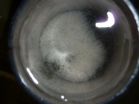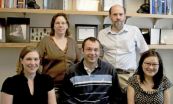(Press-News.org) Bacteria can talk to each other via molecules they themselves produce. The phenomenon is called quorum sensing, and is important when an infection propagates. Now, researchers at Linköping University in Sweden are showing how bacteria control processes in human cells the same way.
The results are being published in the journal PLOS Pathogens with Elena Vikström, researcher in Medical Microbiology, as the main author.
When an infection is signaled, more and more bacteria gather at the site of the attack – a wound, for example. When there are enough of them, they start acting like multicellular organisms. They can form biofilms, dense structures with powers of resistance against both antibiotics and the body's immune defence system. At the same time, they become more aggressive and increase their mobility. All these changes are triggered when the communication molecules – short fatty acids with the designation AHL – bind to receptors inside the bacterial cells; as a consequence various genes are turned on and off.
AHL can migrate freely through the cell membrane, not just in bacterial cells but also our own cells, which can be influenced to change their functions. In low concentrations white blood cells, for example, can be more flexible and effective, but in high concentrations the opposite occurs, which weakens our immune defences and opens the door for progressive infections and inflammations.
A team at Linköping University is the first research group in the world to show how AHL can influence their host cells. Using biochemical methods, the researchers have identified a protein designated IQGAP, which they single out as the recipient of the bacteria's message, and something of a double agent.
"The protein can both listen in on the bacteria's communication and change the functions in its host cells," Vikström says.
Their laboratory studies were carried out on human epithelial cells from the intestines, which were mixed with AHL of the same type produced by Pseudomonas aeruginosa, a tough bacterium that causes illnesses in places like the lungs, intestines, and eyes. With the help of mass spectrometry, they have been able to see which proteins bind AHL.
"We have proof that physical contact between bacteria and epithelial cells is not always required; the influence can happen at a distance," Vikström says.
The team's discovery can open the door to new strategies for treatment where antibiotics cannot help. One possibility is designing molecules that bind to the receptor and block the signal path for the bacteria – something like putting a stick in a lock so the key won't go in. It's a strategy that could work with cystic fibrosis, for example, an illness where sticky mucus made of bacterial biofilm and large amounts of white blood cells is formed in the airways.
###
Article: The Pseudomonas aeruginosa N-acylhomoserine lactone quorum sensing molecules target IQGAP1 and modulate epithelial cell migration by T Karlsson, M V Turkina, O Yakymenko, K-E Magnusson and E Vikström. PLOS Pathogens Vol 8 issue 10, October 2012.
How bacteria talk to each other and our cells
2012-11-06
ELSE PRESS RELEASES FROM THIS DATE:
Combating a crisis: Global burden of preterm birth can be reduced if critical actions are taken
2012-11-06
New surveys of researchers and funders reveal a lack of consensus regarding researching and developing interventions to prevent prematurity and stillbirth, according to an article published in the American Journal of Obstetrics and Gynecology ahead of World Prematurity Day on November 17.
Authored by Michael G. Gravett, MD, scientific director of the Global Alliance to Prevent Prematurity and Stillbirth (GAPPS), an initiative of Seattle Children's, and Craig E. Rubens, MD, PhD, executive director of GAPPS, the article outlines significant opportunities to enhance research ...
New bacteria to fight against intestinal inflammation
2012-11-06
This protection is provided by a human protein, Elafin, which is artificially introduced into dairy produce bacteria (Lactococcus lactis and Lactobacillus casei). In time, this discovery could be useful for individuals suffering from chronic inflammatory diseases such as Crohn's disease or ulcerative colitis.
The results of this research were published in the Science Translational Medicine review on 31 October 2012.
In France, nearly 200,000 individuals suffer from chronic inflammatory bowel disease, known as IBD, (specifically Crohn's disease and ulcerative colitis). ...
Supercomputing for a superproblem: A computational journey into pure mathematics
2012-11-06
A world-famous mathematician responsible for solving one of the subject's most challenging problems has published his latest work as a University of Leicester research report.
This follows the visit that famed mathematician Yuri Matiyasevich made to the Department of Mathematics where he talked about his pioneering work. He visited UK by invitation of the Isaac Newton Institute for Mathematical Sciences.
In 1900, twenty-three unsolved mathematical problems, known as Hilbert's Problems, were compiled as a definitive list by mathematician David Hilbert.
A century later, ...
New strategy for fingerprint visualization developed at Hebrew University
2012-11-06
Jerusalem, Nov. 6, 2012 -- Identifying fingerprints on paper is a commonly used method in police forensic work, but unfortunately it is not easy to make those fingerprints visible. Now, scientists at the Hebrew University of Jerusalem have developed a new approach for making such fingerprints more readily readable.
The new method, created by a team headed by Prof. Yossi Almog and Prof. Daniel Mandler of the Institute of Chemistry at the Hebrew University, uses an innovative chemical process to produce a negative of the fingerprint image rather than the positive image ...
Strange diet for methane consuming microorganisms
2012-11-06
This press release is available in German.
Methane is formed under the absence of oxygen by natural biological and physical processes, e.g. in the sea floor. It is a much more powerful greenhouse gas than carbon dioxide. Thanks to the activity of microorganisms this gas is inactivated before it reaches the atmosphere and unfolds its harmful effects on Earth's climate. Researchers from Bremen have now proven that these microorganisms are quite picky about their diet.
All life on Earth is based on carbon and its compounds. Cell components of all creatures contain carbon. ...
Early treatment sparks striking brain changes in autism
2012-11-06
When given early treatment, children with autism spectrum disorders (ASD) made significant improvements in behavior, communication, and most strikingly, brain function, Yale School of Medicine researchers report in a new study.
The study was published in the current issue of the Journal of Autism and Developmental Disorders by Yale Child Study Center researchers Fred Volkmar, M.D., Kevin A. Pelphrey, and their colleagues.
The results suggest that brain systems supporting social perception respond well to an early intervention behavioral program called pivotal response ...
HF patients treated by a cardiologist, rather than hospitalist, have fewer readmissions
2012-11-06
MINNEAPOLIS, MN – November 6, 2012 – When a cardiologist attends to heart failure patients, even when the severity of illness is higher, patients have reduced rates of hospital readmissions, compared with those patients who are treated by a hospitalist, according to a trial being presented today at the American Heart Association's scientific sessions in Los Angeles.
Congestive heart failure (CHF) is the most common cause for hospital readmission in patients over the age of 65 years. Whereas efforts to reduce readmission rates have focused on transitions of care and short-term ...
Living abroad can bring success -- If you do it right
2012-11-06
"Travel broadens the mind" goes the old adage, and potential employers often agree, valuing the open-mindedness and creativity fostered by such worldliness. But according to new Tel Aviv University research, not all international experiences are created equal.
"Although living abroad does help to hone creative abilities, not all individuals who have lived abroad derive an equal benefit from such experiences," explains Dr. Carmit Tadmor of TAU's Recanati School of Business, who conducted the study with Dr. Adam Galinsky of the Kellogg School of Management at Northwestern ...
Team finds a new way to inhibit blood clotting and inflammation
2012-11-06
CHAMPAIGN, lll. — Scientists have identified a group of small molecules that interfere with the activity of a compound that initiates multiple steps in blood clotting, including those that lead to the obstruction of veins or arteries, a condition called thrombosis. Blocking the activity of this compound, polyphosphate, could treat thrombosis with fewer bleeding side effects than the drugs that are currently on the market.
Their findings appear in the journal Blood.
Blood clots are formed at the site of an injured blood vessel to prevent blood loss. Sometimes, however, ...
New study reveals challenge facing designers of future computer chips
2012-11-06
To build the computer chips of the future, designers will need to understand how an electrical charge behaves when it is confined to metal wires only a few atom-widths in diameter.
Now, a team of physicists at McGill University, in collaboration with researchers at General Motors R&D, have shown that electrical current may be drastically reduced when wires from two dissimilar metals meet. The surprisingly sharp reduction in current reveals a significant challenge that could shape material choices and device design in the emerging field of nanoelectronics.
The size of ...



